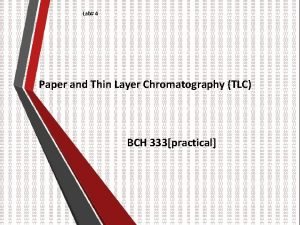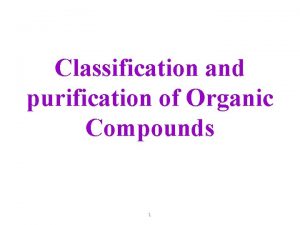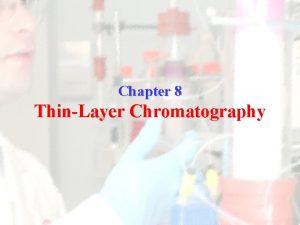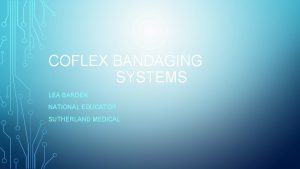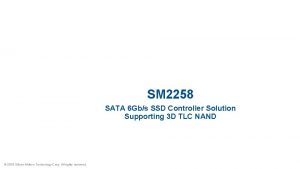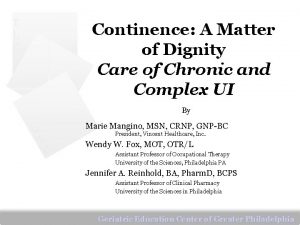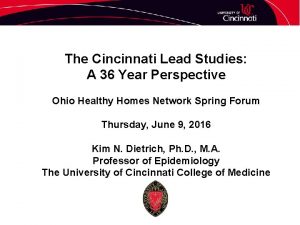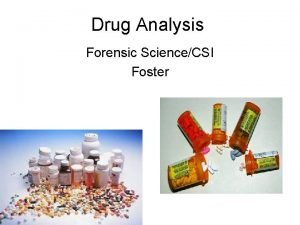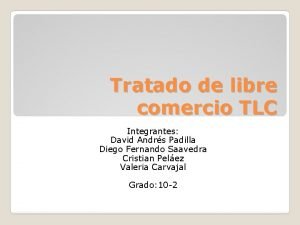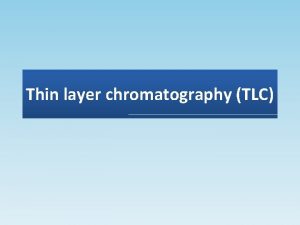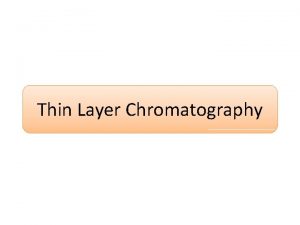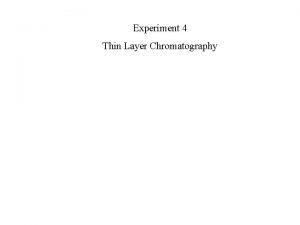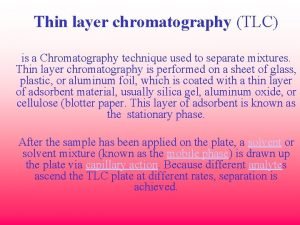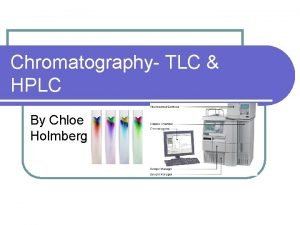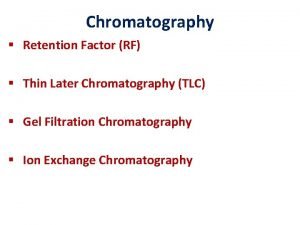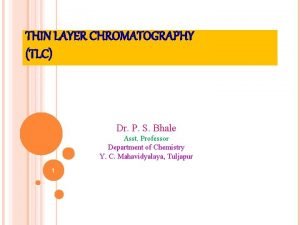THIN LAYER CHROMATOGRAPHY Thin layer chromatography TLC is









- Slides: 9


THIN LAYER CHROMATOGRAPHY • Thin layer chromatography (TLC) is an important technique for identification and separation of mixtures of organic compounds. It is useful in: • Identification of components of a mixture (using appropriate standards) • following the course of a reaction, • analyzing fractions collected during purification, • analyzing the purity of a compound. • In TLC, components of the mixture are partitioned between an adsorbent (the stationary phase, usually silica gel, Si. O 2) and a solvent ( the mobile phase) which flows through the adsorbent.

THIN LAYER CHROMATOGRAPHY In TLC, a plastic, glass or aluminum sheet is coated with a thin layer of silica gel. A very small amount of a solution of the substance to be analyzed is applied in a small spot with a capillary tube, ~1 cm from the bottom of the TLC plate The TLC is developed in a chamber which contains the developing solvent (the mobile phase). A truncated filter paper placed in the chamber serves to saturate the chamber with mobile phase.

THIN LAYER CHROMATOGRAPHY Once the solvent is within ~1 -2 cm of the top of the TLC sheet, the TLC is removed from the developing chamber and the farthest extent of the solvent (the solvent front) is marked with a pencil. The solvent is allowed to evaporate from the TLC sheet in the hood. The spots are visualized using a UV lamp. A fluorescent compound, usually Manganeseactivated Zinc Silicate, is added to the adsorbent that allows the visualization of spots under a blacklight (UV 254). The adsorbent layer will fluoresce light green by itself, but spots of analyte quench this fluorescence and appear as a dark spot. http: //orgchem. colorado. edu/hndbksupport/TLCprocedure. html

THIN LAYER CHROMATOGRAPHY - Visualization As the chemicals being separated may be colorless, several methods exist to visualize the spots: Chromatogram of 10 essential oils, Stained with vanillin reagent. • Visualization of spots under a UV 254 lamp. The adsorbent layer will thus fluoresce light green by itself, but spots of analyte quench this fluorescence. • Iodine vapors are a general unspecific color. • Specific color reagents exist into which the TLC plate is dipped or which are sprayed onto the plate. • Once visible, the Rf value of each spot can be determined

THIN LAYER CHROMATOGRAPHY Calculation of Rf’s The Rf is defined as the distance the center of the spot moved divided by the distance the solvent front moved (both measured from the origin)

THIN LAYER CHROMATOGRAPHY Calculation of Rf’s The Rf is defined as the distance the center of the spot moved divided by the distance the solvent front moved (both measured from the origin)

THIN LAYER CHROMATOGRAPHY – Rf’s Rf values can be used to aid in the identification of a substance by comparison to standards. The Rf value is not a physical constant, and comparison should be made only between spots on the same sheet, run at the same time. Two substances that have the same Rf value may be identical; those with different Rf values are not identical.

Resolution The separation between two analytes on a chromatogram can be expressed as the resolution, Rs and can be determined using the following equation: Rs = (distance between center of spots) (average diameter of spots) In TLC, if the Rs value is greater than 1. 0, the analytes are considered to be resolved. x x
